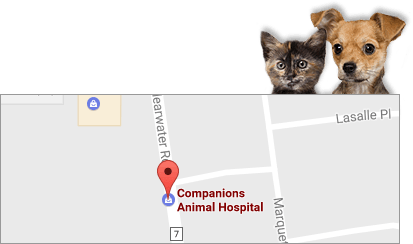 Last time we talked about recognizing that pets can and do experience pain. In addition to experiencing pain however, they are motivated to hide the fact that they are in pain. This is such a terrible combination but something we have to deal with as both owners and veterinarians. Some kinds of pain are good/beneficial – for example, if your pet jumps up on the stove and touches a hot burner – his nervous system sends information to his brain that this is painful and causes him to remove the foot from the source of heat. A very good reason to appreciate pain on some level. Otherwise burns, trauma and cuts could be much worse and life threatening.
Last time we talked about recognizing that pets can and do experience pain. In addition to experiencing pain however, they are motivated to hide the fact that they are in pain. This is such a terrible combination but something we have to deal with as both owners and veterinarians. Some kinds of pain are good/beneficial – for example, if your pet jumps up on the stove and touches a hot burner – his nervous system sends information to his brain that this is painful and causes him to remove the foot from the source of heat. A very good reason to appreciate pain on some level. Otherwise burns, trauma and cuts could be much worse and life threatening.
Some kinds of pain are not so good. Chronic pain, including pain from arthritis, is not beneficial. So, what do we do to treat pain so that our pets do not suffer.
If a pet has a predisposing factor for development of arthritis (working dog, Lyme disease, knee cap issues like patellar luxation, hip dysplasia, previous trauma or torn ligaments etc.) or has early arthritis already it is important to start disease modifying agents BEFORE arthritis becomes severe. This includes things like Adequan, hyaluronic acid, glucosamine/chondroitin sulfate (Dasuquin), and long-chain omega fatty acids. Some of these are by mouth, some are injectable. The more you can do the better chance you have to protect the joints.
The next thing is weight loss. The sad fact is that 2 recent studies have shown incidence levels near 50% for our companion animals being overweight. Not only does this predispose that pet to getting arthritis in the first place, it means more pain once the pet has arthritis. We had one dog that once he lost 30 pounds got off all of his anti-inflammatory pain medications for more than a year. Getting your pet to a good weight may not be easy for you but it is without a doubt the best thing you can do for him or her.
Keeping muscles strong with exercise also benefits patients with arthritis. You have to be careful not to overdo it (no weekend warrior situations) but regular, controlled exercise, physical therapy and rehabilitation are terrific.
Alternative therapies like myofascial trigger point therapy, acupuncture, platelet rich plasma and stem cell therapy are all helpful; once again, early treatment and control will offer more benefits for the pet in pain. These can still be used late in the course of disease but the cost:benefit ratio is better when started early.
Lastly we address medical management; the dreaded “drug therapy” which seems to make a lot of clients wince just to say it. The truth is, at some point, many pets need this to be comfortable and have a good quality of life. Yes, drugs have side effects, and yes, monitoring for these side effects is important. The flip side is more months to years with your beloved friend, companion, house mate, and confidante who is happy, comfortable and enjoying life; not hiding his pain from the person he most wants to protect.
The most difficult thing to convince clients of is treating pain early and often so as to reduce damage to the joints, reduce the phenomenon of wind up pain and hopefully, by doing this, reduce the amount of drug therapy that will be needed down the road.












